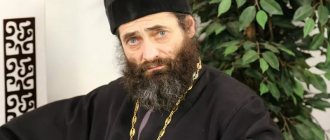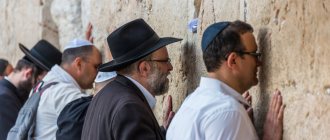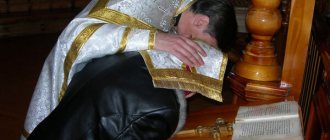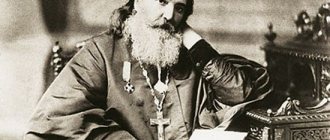Issues of external pious behavior often concern parishioners of many churches. How to address clergy correctly, how to distinguish them from each other, what to say when meeting? These seemingly little things can confuse an unprepared person and make him worry. Let's try to figure out whether there is a difference in the concepts of “priest”, “priest” and “priest”?
The priest is the main character of any worship service.
Where did priests come from?
At all times, in all religions, there were people who were called “clergymen” in Soviet textbooks. In fact, they could be called differently, but the main thing was that these people played the role of intermediaries between a person and the spiritual forces that he worshiped. “Servants of the cult” prayed to these forces and made sacrifices to them. Although the priesthood existed (and exists) in most religious systems, the spiritual forces with which they deal are different. Therefore, it is very important to know to whom the sacrifice is made, to whom exactly this or that people worships.
In this regard, the Orthodox clergy has no connection with pagan priests, shamans, etc. They recognize their kinship with the priesthood of the Old Testament Israel, because the priests who, together with the prophet Moses, led the Jews to the Promised Land, worshiped the same God who is worshiped and Christians to the God of the Bible.
The priesthood of the Old Testament appeared almost 1500 years before Christ, when the Jews emerged from slavery in Egypt into the Promised Land. Then, on Mount Sinai, God gave Moses the famous Ten Commandments and many other laws that determined the religious and civil life of Israel. A separate chapter dealt with the place where the Israelites were supposed to make sacrifices to God, as well as the people who had the right to do this. This is how the tabernacle first appeared - a camp temple where the tablets of the Covenant were kept (two stone tablets on which the Ten Commandments were carved by God), and the ministers of the tabernacle. Later, following the model of this tabernacle, King Solomon built a huge temple in Jerusalem. All Israelis participated in the service, but only the priests could perform it. Moreover, just like the New Testament priesthood, the Old Testament priesthood was structured hierarchically, but it also had a significant difference - it was hereditary. For Orthodox Christians, the connection with the priesthood of the Old Testament is living and immediate. In Orthodox churches you can see icons of Old Testament high priests and priests. For example, children are still baptized with the name of the Old Testament priest Zechariah (Father John the Baptist).
The New Testament priesthood comes into being as a result of the coming of Jesus Christ into the world. New Testament priests serve the same biblical God. However, the way and meaning of their ministry changed. If in the Old Testament all sacrifices were tied to a specific place: they could only be offered in the Jerusalem Temple, then the New Testament sacrifice to God ceased to be associated with geography. The nature and essence of the sacrifice changed. In all religions, at all times, among all peoples, a person makes a sacrifice to the gods and their subsequent response to it is expected. In Christianity, on the contrary, God sacrifices Himself for people, literally sacrifices Himself on the Cross. Having made this sacrifice, the Lord awaits a response from man... It is with Golgotha that the ministry of the New Testament priesthood is connected. During the main Christian service - the Liturgy - through the prayer of believers with a priest at the head, Christ Himself makes a sacrifice, offers Himself. Then Christians unite with the Savior, partaking of His Body and Blood.
The biblical book entitled “The Acts of the Apostles” gives an idea of how the Church grew and developed in the first thirty years of its existence, how its three-tier hierarchical structure gradually took shape, which we see to this day. The first whom Christ blessed for the New Testament priestly service were His twelve closest disciples. In another way they are called apostles. From Greek this word is translated as “messenger”, or “envoy on a special mission.” This mission consisted of three things: priesthood, teaching and governance of the Church.
At first, the apostles did everything themselves - baptized, preached, dealt with a variety of economic issues, collecting and distributing donations, etc. But the number of believers quickly increased. Therefore, it was decided that economic and material issues would henceforth be dealt with by specially selected representatives of the community, so that the apostles would have enough time to fulfill their direct mission - performing divine services and preaching the Risen Christ. Seven people were elected who became the first deacons of the Christian Church (from the Greek diaconos - minister). A deacon is the first hierarchical level of the priesthood.
When the number of believers already reached thousands, twelve people were physically unable to cope with either the sermon or the sacred rites. In large cities, the apostles began to ordain people on whom they actually entrusted their functions: priesthood, teaching and administration. These people were called bishops (from the Greek - episcopos - overseer, overseer). The only difference between the bishops and the first twelve apostles was that the bishop had the power to officiate, teach and govern exclusively on the territory of his diocese (from the Greek eparchia - region, possession). And this principle has been preserved to this day.
Soon the bishops also needed helpers. The number of believers grew, and the bishops of large cities were physically unable to cope with the load that fell on them. Every day they had to perform divine services, baptize or perform funerals - and at the same time in different places. Therefore, bishops began to appoint priests to serve. They had the same power as bishops, with one exception - priests could not ordain people and performed their ministry only with the blessing of the bishop. Deacons, in turn, assisted both priests and bishops in serving, but they did not have the right to perform the Sacraments. In the Ancient Church, deacons played a huge role as the closest assistants and confidants of bishops, but gradually in the Orthodox Church their importance was reduced only to helping priests during divine services. After some time, a tradition developed that only those people who were first ordained to the diaconate became priests.
Priests are also called shepherds. This word does not indicate that all other Christians are a flock of silent sheep. A pastor is a measure of responsibility before God for every person a priest meets in his life. And the power of the priest always borders on this responsibility. Therefore, it is to the clergy, first of all, that the words of Christ are addressed: “To whom much is given, much will be required.”
What is apostolic succession?
One of the four essential properties of the Church, without which it cannot exist, is apostolate. This property essentially means that the Church always remains internally identical to the Church that it was under the apostles. However, this identity is determined by a number of very important external and internal characteristics, one of them is apostolic succession.
The priesthood is not inherited: priests are not born, but become. The acquisition of the grace of the priesthood occurs in the Church Sacrament. During this Sacrament, the bishop places his hands on the candidate’s head (hence the name of the rite - Ordination) and reads special prayers, thus becoming, as it were, the “father” of the newly ordained priest. If we trace the “family tree” of such ordinations into the depths of the past, we will discover why we are talking about apostolic succession. The fact is that, having reached the beginning of this chain of ordination, we discover an amazing fact: each ordained clergyman has one “ancestor”. This “ancestor” will be one of the twelve apostles of Christ.
Apostolic succession is one of the conditions that the Church is grace-filled, that the Sacraments are actually performed in it, which means that it fulfills its purpose - to lead people to salvation. However, apostolic succession is not limited to the unbroken chain of ordinations itself. Another condition is also necessary: the Church must preserve the doctrine that it received from the apostles (and the apostles from Christ Himself). Without this, no genuine apostolic succession exists.
Deductions
You can't get a good seat if you don't unfasten it up. Without this, the priest will not last even a month. Every major holiday, the head of the diocese tries to serve in large churches. There, money is transferred, not only to him, but also to everyone who serves with him - each in an envelope. The abbot can give away more than half (sometimes even up to 80%) of the profit, which simply goes past the cash register, without going through the papers anywhere. Then everything goes higher and higher in chains. One chain is very short: in a diocese where there are few priests, everything is given directly to the bishop. If it is a large, sprawling bureaucratic machine, as in the Moscow region, then everything goes through the deans. All this is in addition to the church tax (about 20%), which is paid officially.
The church elite accumulates these funds. When a person enters the first year of seminary, he already sees this goal. A bad seminarian is one who does not want to become a bishop. Why? Precisely because of the benefits that can be received.
A year after his appointment, the bishop can buy a house somewhere in Italy.
A year after his appointment, the bishop can buy a house somewhere in Italy. Keeping money in accounts is bad form. As a rule, people buy themselves expensive jewelry, crosses with precious stones, improve their life as much as possible: they furnish the house like a manor’s estate, and do not refuse expensive foods. One man in office in St. Petersburg asked to bring him oysters so that they would “squeak.” He eats her, and she squeaks.
Priesthood and marriage
As the Church expanded, as people appeared who preferred monastic life to family life, different types of Christian life began to take shape. A division of the clergy into “white” and “black” appeared. Married priests are conventionally called “white,” and monastics are called “black.” In the first centuries of the Church's existence, all clergy (even bishops) could have families, but by the end of the first millennium, West and East diverged on this issue. In the West, mandatory celibacy was introduced, that is, celibacy of the priesthood. In the East, on the contrary, non-monastic priests were required to marry before ordination. However, before performing the Sacrament of Ordination, the future priest takes off his wedding ring and places it on the throne as a sign that his life now belongs only to God. That is why, according to church canons (rules), a person who has become a priest, being unmarried, does not have the right to marry after being ordained. Consequently, marriages of clergy are of particular importance for the Church.
The fact is that in his ministry, in his life, a priest must be the image of Christ, demonstrate the gospel ideal. The Gospel contains two maxims of Christian life - virginity for the sake of Christ and a family where spouses remain faithful to each other all their lives. Understanding human weaknesses, the Church makes leniency for the laity and blesses, in exceptional cases, up to three marriages. However, from married priests it fully requires the embodiment of the Gospel ideal of family in life. Following precisely the evangelical ideal, the Church does not elevate second-married people to the priesthood, but requires a priest who is divorced to remain celibate for the rest of his life.
How to contact priests
Within each of the three hierarchical levels there is its own hierarchy. The Sacrament of the Priesthood is performed only when the candidate is elevated to the next of the three levels. As for the hierarchy of titles within these levels, in ancient times they were associated with special church obediences, and now - with administrative power, special merits, or simply the length of service to the Church.
The word "priest" has several Greek synonyms.
For the white priesthood:
- Priest (priest; from Greek hierуs - sacred).
- Presbyter (from Greek presbyteros, literally – elder)
- Protopresbyter (first elder)
- Archpriest (first priest)
For the black priesthood:
- Hieromonk (monk in the rank of priest)
- Hegumen (from the Greek hegumenos, literally - going ahead, leader, commander), in ancient times (and in the modern Greek Church) only the abbot of the monastery; in modern practice of the Russian Church, the title can be given to simple hieromonks for special merits and after a certain period of time service to the Church.
- Archimandrite (from the Greek archon - head, elder and mandra - sheepfold; literally - elder over the sheepfold), that is, the elder over the monastery. The word “mandra” was used to describe monasteries in Greece. In ancient times, only the abbot of one of the largest monasteries (in the modern Church of Constantinople and Greece this practice is preserved, however, an archimandrite can be both an employee of the Patriarchate and an assistant to the bishop). In modern practice of the Russian Church, the title can be given to the abbot of any monastery and even simply to abbots for special merits and after a certain period of service to the Church.
The words pop and protopop stand apart. In Rus', these words did not have any negative meaning. Apparently, they come from the Greek “pappas”, which means “daddy”, “father”. This word (due to its prevalence among the Western Slavs) probably came into the Russian language from Old High German: pfaffo - priest. In all ancient Russian liturgical and other books, the name “priest” is constantly found as a synonym for the words “priest, priest and presbyter.” Protopop is the same as protopresbyter or archpriest.
As for appeals to priests, they exist official and unofficial. Unofficially, priests and deacons are usually called fathers: “Father George”, “Father Nikolai”, etc. Or simply “father”. On official occasions, the deacon is called “Your Reverence,” the presbyter “Your Reverence,” the protopresbyter “Your Reverence.” When addressing a bishop, they say “Vladyka” (Vladyka George, Vladyka Nikolai). In the Russian Orthodox Church, when formally addressing a bishop, he is called “Your Eminence,” while archbishops and metropolitans are called “Your Eminence.” The Patriarch is always addressed: “Your Holiness.” All these appeals relate not to the person’s personality, but to his ministry.
Who was the first Christian priest?
This is unknown. But already in the book of Acts “church elders” are mentioned in Ephesus, who were not bishops, like the disciple of the Apostle Paul, Timothy. In the first centuries there were chorepiscopes, that is, “rural bishops.” Often chorebiscopes and presbyters differed little. The deepest antiquity is still noticeable in the deacon’s exclamation “Bless, Master” when addressing a priest, and not a bishop. In the Byzantine tradition, the priest is clearly ordered to sit in a headdress (nowadays kamilavka or miter) while reading the Apostle at the Liturgy, which signifies the “equalness of the apostles” of the priestly service. In the earliest canonical rules there is a constant confusion of the concepts of bishop and presbyter; it is almost impossible to distinguish between them.
Confessor - who is this?
People who are not sufficiently familiar with the life of the Orthodox Church, but have Orthodox acquaintances, can often hear the word “spiritual father” in their speech. For example, “my confessor said...”, “my confessor advised me...”, etc. Non-church people, hearing this, may think that there is another special level of priesthood in the Church. This is wrong. The confessor is the same priest or bishop (which happens much less frequently due to their enormous administrative burden). The only peculiarity of a confessor lies in the nature of the relationship between him and a specific parishioner of an Orthodox church. For example, for confession a person can approach any priest in any church.
However, if we are talking not only about performing the Sacrament of Confession (forgiveness of sins on behalf of God), but also about receiving advice, about additional conversation, help in solving various issues and difficulties in the life of a Christian, the parishioner naturally strives to find a priest with whom in the future his church life will be connected. If a priest, in turn, delves into and knows all the problems of this person and helps resolve them from a spiritual point of view, shares with him the spiritual experience of life in the Church, then he is called a spiritual father or confessor, and the parishioner, respectively, a spiritual son or spiritual daughter . The very name “spiritual father” is due to the fact that it is he who helps a person to be spiritually born, that is, to experience for himself what real spiritual life is and how to live it.
The presence of a confessor is not a mandatory condition for a person to remain in the Church. However, without a confessor it is very difficult to adopt the living experience of spiritual life. The influence of the confessor is based solely on his authority with the spiritual son (or daughter) and does not have any formal consequences for the salvation of a person.
magazine "Foma", 07.16.05
Notes
- [comparing confessional paintings of 1757: TsGIASPb, F.19 (Petrograd Spiritual Consistory), Op.112, No. 138 and confessional paintings of 1758: TsGIASPb, F.19 (Petrograd Spiritual Consistory), Op.112, No. 144]
Presbytery Priest • Hieromonk • Archpriest • Hegumen • Protopresbyter • Archimandrite Diaconate Deaconess • Subdeacon • Deacon • Hierodeacon • Protodeacon • Archdeacon Low clergy Beller • Exorcism • Kirofor • Reader Elders Monsignor (Prothonotary · Prelate Emeritus · Chaplain to His Holiness) · Vicar General · Episcopal Vicar · Canon · Probst · Archpriest · Dean (or District Vicar) · Pastor · Parish Administrator · Parish Vicar · Curate · Assistant Pastor · Chaplain Deacons Deacon · Permanent deacon Servants during the Liturgy Acolyte · Reader · Ceremoniary · Minister (Turiferarium · Cruciferarium) For certain tasks Prefect · Papal Legate · Apostolic Nuncio · Military Ordinary · Apostolic Administrator · Diocesan Administrator · Apostolic Vicar · Apostolic Prefect · Penitentiary · Archdeacon · Primicerium · Rector In Eastern Catholic churches Exarch · Archimandrite In Catholic orders Superior General · Provincial · Primate Abbot · Abbot (Mitred Abbot · Abbot Regular) · Novitius Abolished Royal Cardinal · Lay Cardinal · Prince-Bishop · District Bishop · Antibishop · Prelate Fiocchetto · Abbot Commendatorium · Subdeacon · Exorcist · Ostiary








